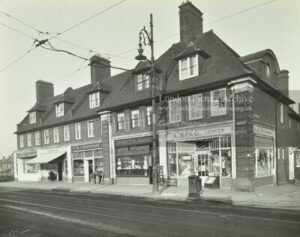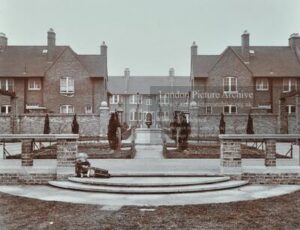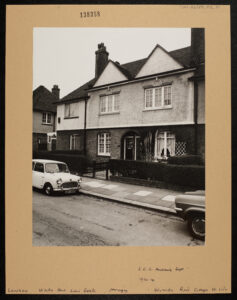History
At the turn of the century Tottenham was a village suburb served by new railways and at the end of the tramlines. It was surrounded by fields, which the newly formed London County Council (LCC) could acquire using as yet hardly used powers to buy land and build Council Housing. Earlier experiments in housing design for workers had produced beautiful picturesque estates modelled on traditional rural housing, such as Port Sunlight, Bourneville and New Earswick.
The National Library of Scotland’s Map Finder includes maps of the area published in 1873, 1894, 1920 and 1946.
Arts and Crafts influence
This new housing was designed by some of the most progressive Architects of their day and were funded by rich social reformers. Their philosophy respected co-operation between Architects and craftsmen and was called the ‘Arts and Crafts Movement’. The LCC placed Britain at the cutting edge of planned social housing, improving conditions for the working classes with well constructed, healthy homes in the highest quality environments.
Samuel Montagu’s donation
In 1898, Ebenezer Howard published ‘Tomorrow – a peaceful path to real reform’. This book launched the Garden City movement and shortly after its publication, Samuel Montagu, of the silversmith and watchmaking family (later Lord Swaything) donated £10 000 to purchase land and to build low density accommodation in a ‘Garden Suburb’ setting. The donation was tied to the rehousing of Jewish workers resident in Tower Hamlets together with the provision of an area of public gardens; giving rise to the name Tower Gardens.
The 954 housing units on Tower Gardens made it the largest development undertaken by the LCC between 1898 and 1914 (other large estates being construction in Tooting, Hammersmith and Croydon). It was also the first estate to be constructed outside of the LCC area, and became the foremost housing achievement of the early LCC.
The London Picture Archive includes a large number of images of the White Hart Lane estate from the 1920s, including the shops on Lordship Lane and Tower Gardens Park.


The Courtauld Collection includes a number of photos of the White Hart Lane estate from the mid-Twentieth century.

Layers of London includes a number of records of First World War conscientious objectors who lived on the estate including Alfred Edward Norman, 1 Awlfield Avenue.
Haringey Council website includes A life in the day of a Tower Gardens resident: Charles Roberts.
The Lordship Rec website has a document covering the history of social activities and events on the Tower Gardens Estate.
Today
Tower Gardens is example of progressive Edwardian Architecture that is unique and rare within the largely Victorian historic fabric of London. Nevertheless, it has survived largely intact to the present day and together with is architectural quality it rightfully retains a special importance worthy of the most rigorous measures towards its conservation.
